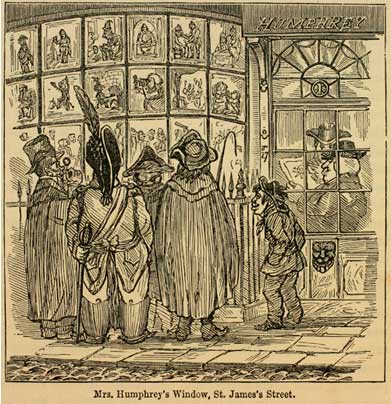The Publishing Scene
Most satirical prints were produced in London and sold singly by publishers and booksellers such as S. W. Fores and William Holland. Starting in the 1790s, Fores advertised that he would lend out portfolios of caricatures for the evening to provide diversion for fashionable soirees. Other prints were first published in magazines and journals, the tabloids of their day. During the day, the newest prints were displayed in the publishers' shop windows, where passersby could stop for a quick glance at the latest scandal, political controversy, or reason for national pride.
In 1807 the publisher Thomas Tegg started a business selling cheap, crudely colored prints aimed at a wide market. Most of the prints in our collection fall into this category. The coloring was done by apprentices, who were typically not paid but worked in exchange for "room and board" (the "room" was often a sleeping mat on the floor of the kitchen). Many of the apprentices to London publishers were French refugees from the Terror.
The publishing scene in France was quite different, since any anti-Napoleon propaganda was quickly quashed by the authorities. Satirical prints there were printed in secret, and circulated clandestinely.

"The works of James Gillray, the caricaturist; with the history of his life and times."
Ed. by Thomas Wright ... With over four hundred illustrations. London, Chatto and Windus [1873]. p. 5
Image not in database
